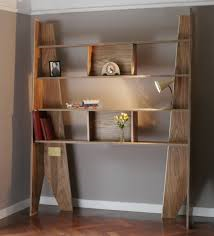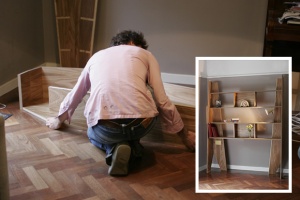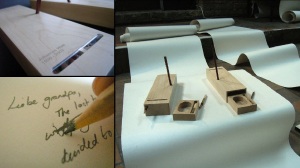 Families aren’t always aware that many options exist other than the synthetic preservatives and impermeable caskets expected to resist the likely forces of decomposition, and in the process we give over thousands of acres of land every year to new cemetery grounds.
Families aren’t always aware that many options exist other than the synthetic preservatives and impermeable caskets expected to resist the likely forces of decomposition, and in the process we give over thousands of acres of land every year to new cemetery grounds.
I like the idea of shelves. A solid, plywood set of floor-standing shelves are designed to last you a lifetime. Then, when your time arrives, the shelves can be taken apart and reassembled as a coffin.
SHELVES FOR LIFE
For those who say “you can’t take it with you” William Warren says otherwise. He is a conceptual designer, a lateral thinker and a joker. His designs engage with people and ask them to rethink the objects around them.
He certainly demonstrates it with his Shelves For Life, a project to further explore ideas of built-in sentimentality within our possessions. But Shelves for Life aren’t for everyone. But there is an element of eco-friendliness at play here alongside the smarty-pants “given buried in, instead of with your possessions” subtext: producing a new coffin is extremely energy- and resource-intensive and by being buried in a piece of repurposed furniture you completely avoid the green and unsustainable getting-buried-in-a-new-coffin thing.
While you’re still on this planet and able to read, the shelves handsomely hold your books and tchotchkes that decorate your life. When your number is called, the shelves can easily disassemble into your final resting place. The upcycled coffin will save your grieving family money, and let you bring a little something familiar into the afterlife.
Like marine life? How about an ocean afterlife. Have your relatives recycle your body into a living reef, and you yourself can become a life supporting vessel for all eternity. Eternal Reefs help restore the fragile ecosystems off our coasts, providing an environment that supports coral and micro-organisms. Your ashes are mixed with cement, then placed off the coast in a military style ceremony, supporting marine life for at least 500 years. Even the practice of scattering ashes at sea has a new wrinkle. Florida-based Great Burial Reef will place urns with cremated remains within 100 percent natural, PH-balanced concrete artificial reefs placed at the bottom of the ocean. And Georgia-based Eternal Reefs will mix your ashes with the cement they use to create “reef balls”—hollow spheres that resemble giant Whiffle balls that are sunk offshore. Loved ones equipped with the GPS coordinates can boat or even dive to visit the site of the remains.
Families aren’t always aware that many options exist other than the synthetic preservatives and impermeable caskets expected to resist the likely forces of decomposition, and in the process we give over thousands of acres of land every year to new cemetery grounds.
I like the idea of shelves. A solid, plywood set of floor-standing shelves are designed to last you a lifetime. Then, when your time arrives, the shelves can be taken apart and reassembled as a coffin.
REST IN PIECES
Nadine Jarvis has turned the concept of the cremation vessel on its head with her Rest in Pieces, Birdfeeder, and pencil box projects. All of the projects utilize cremation ashes in unique and thought-provoking ways, and they are aimed at assisting in the grieving and healing process. Jarvis designed the projects with a focus on the concept of impermanence and renewal.
Nadine Jarvis has created the ultimate afterlife memento for authors and scribblers everywhere. Coming in a flat wooden box, Jarvis creates a set of pencils from human ash — a body yields on average around 240 green pencils! The special container allows only one pencil to be withdrawn at a time. The pencil is sharpened on the side of the box, which holds the ash shavings. When the last pencil is used, the box becomes an urn, holding the remaining ashes.

